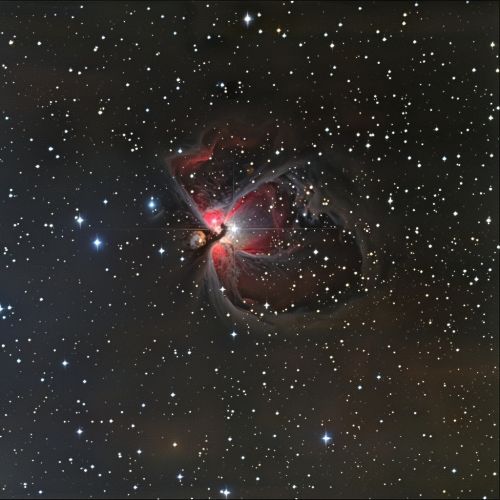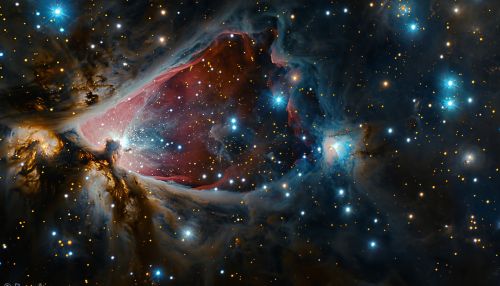Betelgeuse
Introduction
Betelgeuse, also known as Alpha Orionis, is a red supergiant star located in the constellation of Orion. It is one of the largest and most luminous observable stars. Betelgeuse is approximately 700 light years away from Earth and is easily visible to the naked eye due to its distinctive reddish color and brightness.


Physical Characteristics
Betelgeuse is a M-type supergiant star, which means it is a high-mass star that has exhausted the hydrogen at its core and has begun to cool and expand. This process has resulted in a diameter that is approximately 900 times larger than our own Sun. If placed at the center of our solar system, its surface would extend past the asteroid belt, engulfing the orbits of Mercury, Venus, Earth, and Mars.
The mass of Betelgeuse is estimated to be about 20 times that of the Sun, but this estimate is uncertain due to the star's size and unusual variable behavior. The star's luminosity varies over time, ranging from a magnitude of +0.2 to +1.2. This variability is thought to be due to pulsations in the star's outer layers.
Spectral Characteristics
The spectrum of Betelgeuse is that of a M2 Iab supergiant. This spectral classification indicates that the star has a surface temperature of approximately 3,500 Kelvin, which gives it a distinctive red color. The "Iab" designation indicates that it is an intermediate-luminosity supergiant, with properties between those of normal supergiants and those of more luminous hypergiants.
The spectrum of Betelgeuse also shows strong lines of titanium oxide, a molecule that forms in the cool atmospheres of M-type stars. Other spectral features include lines of neutral metals and ions, as well as bands of carbon-based molecules such as CO and CN.
Variability
Betelgeuse is a semi-regular variable star, which means that it exhibits changes in brightness due to pulsations in its outer layers. These pulsations are thought to be driven by processes related to nuclear fusion in the star's core. The star's variability period is approximately 420 days, but shorter and longer-term variations have also been observed.
In late 2019, Betelgeuse underwent a dramatic dimming event that caused its brightness to decrease by more than a factor of two. This event, known as the "Great Dimming", sparked widespread interest and speculation about the star's future. Some suggested that it could be a precursor to a supernova explosion, but subsequent observations have shown that the star has returned to its normal brightness.
Future Evolution
As a red supergiant, Betelgeuse is nearing the end of its life. It has exhausted the hydrogen fuel in its core and is now burning helium. Eventually, the star will exhaust its helium fuel and begin to burn heavier elements. This process will continue until the star's core is composed primarily of iron, at which point nuclear fusion will no longer be possible.
When this happens, the core of Betelgeuse will collapse under its own gravity, triggering a supernova explosion. The resulting explosion will be one of the most spectacular events in the history of astronomy, visible from Earth even during the day. However, this event is not expected to occur for at least another 100,000 years.
